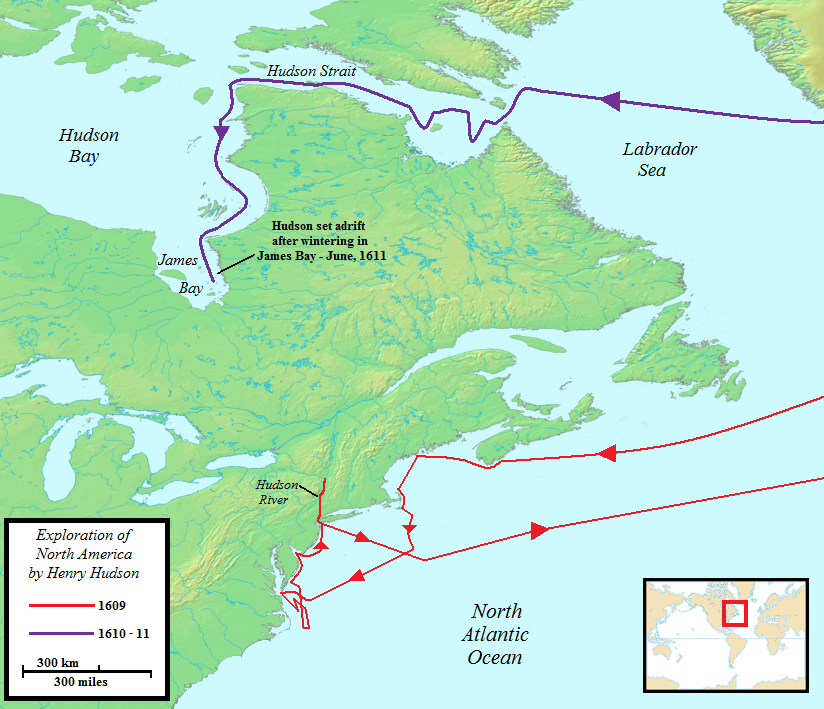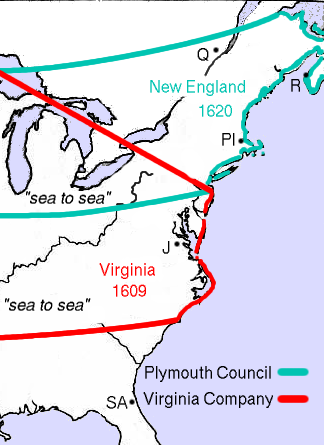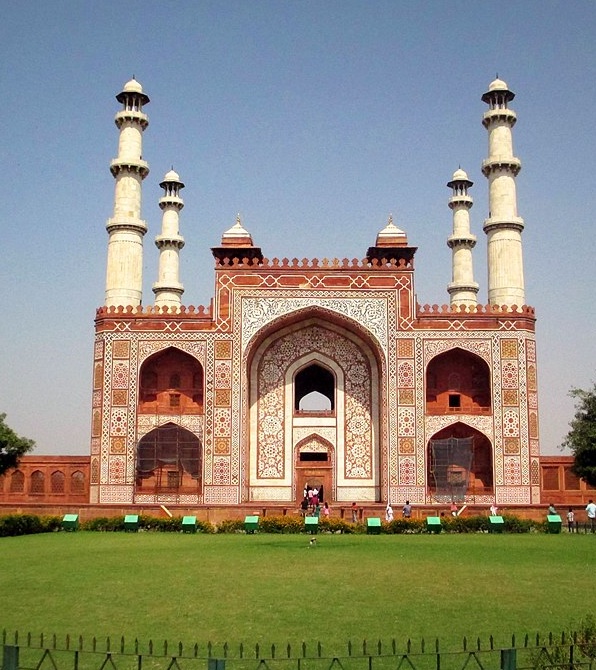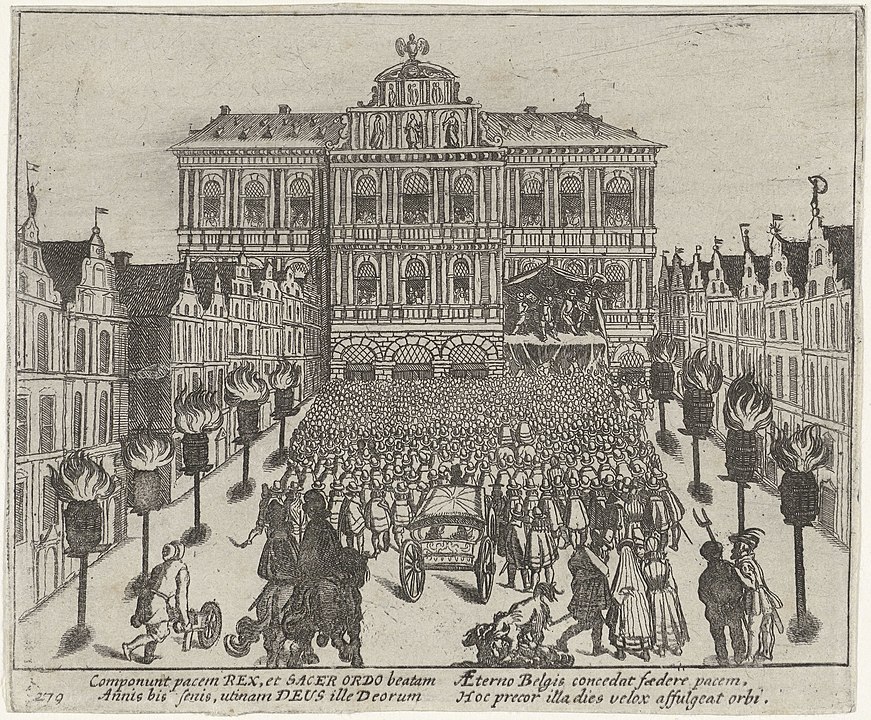History is speeding up, and it becomes ever harder to extract just the most important events of each year. For 1609, I’ve identified two “bigger” stories and six smaller ones. Let’s go with the smaller ones first. Bigger two at the end.
1. Henry Hudson sails up American river later named after him
In April, Hudson, an Englishman and already an experienced explorer, set out from Amsterdam on a ship owned by the Dutch East India Company (VOC). He was originally instructed to find the long-sought “northeast passage” to East Asia, that is by going northeast around Russia. But he had also heard about a possible “northwest passage” (going around or cutting through North America), so when he got blocked by ice from getting around Russia he headed west instead, touching down in Newfoundland and Nova Scotia, zigzagging around the foot of the Chesapeake, then heading north up the American coast. He found a big, promising-looking river draining southward into the ocean and sailed up it as far as today’s Albany, NY.
On returning to Europe, he put in at Dartmouth, England, where perhaps understandably the authorities detained him and tried to confiscate his logbook. (He had been working as a mercenary for a foreign company!) He smuggled the logbook to the Dutch, who then claimed “ownership”– or anyway, settlers’ rights– over the newly “discovered” river.
In late July, when the boat was in Nova Scotia, a dozen men from it went ashore with muskets and small cannon, “and assaulted the village near their anchorage. They drove the people from the settlement and took their boat and other property.”
(I find it interesting how many of the leaders of these significant early European colonizing expeditions were acting as, in essence mercenaries for foreign entities.)
2. Virginia Company gets new, more expansive charter
You may recall that when the “Virginia Company” got a royal charter in London in 1606, the charter specified fairly precise limits for how far each of the two envisioned colonies could extend. (As I recall, it was 50 miles.) Now, in May 1609, the company was granted a second charter that,
provided “a further Enlargement and Explanation of the said [first] Grant, Privileges, and Liberties”, which gave the London Company adventurers influence in determining the policies of the company, extended the Company’s rights to land extending “up into the Land throughout from Sea to Sea”, and allowed English merchant companies and individuals to invest in the colonization effort. The charter includes a detailed list of the names of some 650 noblemen, gentlemen, officials, companies, and individuals who subscribed as investors.
The “sea to shining sea” aspect of this charter mirrored to some extent what the Portugal’s King John II had done in 1534 to organize the colonization of the interior of Brazil. Except that the line drawn by the “London Branch” of the Virginia Company, which was the only branch that had an even semi-viable tiny colony by 1609, veered northwest rather than straight west.
3. An Englishman lands in Bermuda and “claims” it
Bermuda had been “discovered” (for Europe) by a Spanish explorer in the early 1500s, and apparently had no indigenous population either then or 100 years later when a guy called George Somers, en route from England to Jamestown, got blown off course and was shipwrecked there. He “claimed” the small Bermuda archipelago for England. Then, smartly, he and the 151 people who had been on his boat used the wreckage of it to build two smaller boats that took them safely to Jamestown. (Where they discovered the settlers near starvation.)
Anyway, three years later the English would start to build a colony on Bermuda, which they called first of all “Virgineola” and later “Somers Isles.”
In 1615, the colony… was passed on to a new company, the Somers Isles Company. As Bermudians settled the Carolina Colony and contributed to the establishment of other English colonies in the Americas, several other locations were named after the archipelago. During this period the first enslaved people were held and trafficked to the islands. These were a mixture of enslaved native Africans who were trafficked to the Americas via the African slave trade and Native Americans who were enslaved from the Thirteen Colonies.
(Of course, there were nowhere close to 13 English colonies on the N. American mainland yet. Just tiny, struggling Jamestown.)
4. VOC imports tea to Europe, builds trading-post in Japan
Tea probably originated in the borderlands of southwestern China and northern Burma and had been widely used in China and Japan as the core of an enjoyable (and sometimes also medicinal or ritually significant) infusion for many centuries. Early during the period of European takeover of the world it became– along with coffee, sugar, pepper, chocolate, and a number of other ingestibles– a new “staple” of the West European diet.
English-WP tells us that:
The earliest European reference to tea, written as chiai, came from Delle navigationi e viaggi written by Venetian Giambattista Ramusio in 1545. The first recorded shipment of tea by a European nation was in 1607 when the Dutch East India Company moved a cargo of tea from Macao to Java, then two years later, the Dutch bought the first assignment of tea which was from Hirado in Japan to be shipped to Europe. Tea became a fashionable drink in The Hague in the Netherlands, and the Dutch introduced the drink to Germany, France, and across the Atlantic to New Amsterdam (New York).
By the way, Hirado was the big trading center in Japan where the VOC established its new warehouse in 1609.
5. Spain establishes settler-city “Buenavista” in Philippines
Another busy year for the Spanish empire. In addition to establishing four new settlements in the Americas (in present-day Peru, Guatemala, Colombia– and St. Simon’s Island, Georgia (USA)– the empire established a new settlement called “Buenavista” in the central Philippines. WP tells us that:
The town was named “Buenavista” by Don Cornelio Sadiua, due to its “good view.” Its former name was Sabang, which is the river that runs through it. The majority of Buenavistans trace their ancestry to the Don Cornelio Sadiua family.
I guess that last sentence tells us something about what Don Cornelio was using the place for.
6. Mughal emperor Jahangir welcomes English “explorer”

William Hawkins was an English navigator who possibly was a nephew of the infamous John Hawkins (father of the English Trans-Atlantic slavetrading tradition.) In 1607 or 1608 he commanded an (English) East India Company ship on a voyage to Surat, which was the Mughal Empire’s main trading port on the Arabian Sea. From there he traveled– presumably with the permission of the Mughal officials– deep inland to Agra, the location of the Mughal capital complex at Fatehpur-Sikri. He reached Emperor Jahangir’s court in April 1609 and remained there nearly three years. English-WP, quoting from the English Dictionary of National Biography, takes up the tale:
According to the account given in his Journal the emperor took much pleasure in his conversation, and detained him, assigning him a handsome maintenance, estimated at upwards of £3,000 a year, his serious occupation being to combat the intrigues of the Portuguese and to endeavour to obtain a formal permission for the establishment of an English factory at Surat. His favour with the emperor enabled him to overcome all difficulties, and the required license was given; it was the first distinct recognition of English commerce in the East.
Jahangir was desirous of attaching him to the country and to his interests, and pressed him to marry a maid out of the palace. Such a wife could also ensure that his food was not poisoned since Jahangir had already told the Jesuits that if Hawkins “dyed by an extraordinary casualtie, they should rue for it.” Hawkins consented to the match, conditionally on her not being a Moor, and accordingly he took as his wife the daughter of an Armenian Christian. Afterwards, having fallen into some disfavour with the emperor, he was allowed to depart, and in this the Portuguese readily assisted him. He left Agra in November 1611, and three months later arrived at Surat, where he found Sir Henry Middleton, with whom he went to the Red Sea, and afterwards to Java.
Hawkins died in 1613 while on the voyage home. But his meeting with Jahangir would later prove momentous. By the way, the banner at the top of this post is a 1690 engraved view of Surat.
7. Spain gives provisional recognition of Dutch independence
In 1607, you will recall, the Dutch navy delivered a shocking blow to the Spanish fleet in Gibraltar Bay… and that, while Spain was plummeting ever deeper into debt. So around then, the Spanish governor of the (Habsburg) Netherlands, King Philip’s brother Archduke Albert, was reaching out to the leadership of the Protestant United Provinces to see about the possibility of a ceasefire, and several months of pre-negotiations followed.
In February 1608, a peace conference was convened in The Hague, with thre main mediators being a French team led by president of the Parliament of Burgundy, Pierre Jeannin, described as an experienced negotiator. England, Denmark, and various other European powers sent delegations.
That conference,
failed to come to an agreement on the terms of a peace treaty and it broke up on 25 August. The parties were unable to compromise in matters of colonial trade and religion. To safeguard the Spanish Empire, the Habsburgs demanded that the Dutch would cease all navigation south of the Equator. It was a price that the mercantile United Provinces refused to pay. The demand inspired Hugo Grotius to publish his famous Mare Liberum in defense of the Dutch refusal. The United Provinces likewise rejected the Habsburg demand that the Catholics in the Republic would be given freedom of religion as an interference in their domestic affairs. In spite of these setbacks, the French and English mediators nevertheless succeeded to convince the two sides to settle for a lengthy truce. It would preserve the peace, while remaining silent on all contentious subjects. After considering longer and shorter periods, the term of the Truce was set for twelve years.
Formal talks were resumed on 28 March 1609 at the Antwerp City Hall. On 9 April the two delegations set their signatures to the text. The ratification process proved difficult… Philip III had his own reasons to [hold back.]. It took several missions from the Archducal Court before he was prepared to ratify the treaty on 7 July 1609.
About the content of the treaty, WP tells us:
The Habsburgs agreed to treat the United Provinces like an independent state for the duration of the Truce. The wording of the article was ambiguous. The Dutch version of the agreement stated more or less that the independence of the Republic had been recognized. The French text suggested that the Republic would be treated as if it were independent.
All hostilities would cease for twelve years. The two parties would exercise their sovereignty in the territories that they controlled on the date on the agreement. Their armies would no longer levy contributions in enemy territory, all hostages would be set free. Privateering would be stopped, with both parties repressing acts of piracy against the other. Trade would resume between the former belligerents. Dutch tradesmen or mariners would be given the same protection in Spain and the Archducal Netherlands as enjoyed by Englishmen under the Treaty of London. This meant that they could not be prosecuted for their beliefs, unless they gave offense to the local population. For their part, the Dutch agreed to end the blockade of the Flemish coast, but refused to allow free navigation on the Scheldt.
So the Dutch Protestant U.P.’s had finally won from the other big states of Western Europe something close to recognition of their independence. This– and the ending of hostilities– had big effects at home. But probably an even bigger effect on their ability to continue pursuing their various imperial projects around the world.
8. Spain expels the “Moriscos”
Well, here we are, 117 years after the fall of the last of the Muslim city-states that prior to 1492 had existed– and flourished– in the Iberian peninsula for more than half a millennium, and… In April 1609, Spanish King Philip III’s long-time pal the Duke of Lerma persuaded the monarch to sign an edict to expel from Spain (which included Portugal) all remaining remnants of the peninsula’s once-vibrant Muslim population, known at that time as the “Moriscos.”
According to English-WP, the Duke of Lerma was aided in his campaign to persuade Philip by,
the Archbishop of Valencia, Juan de Ribera, who considered the Moriscos as universally heretics and traitors. The archbishop added an idea to make the plan more persuasive to the king: the king could confiscate the assets and properties of the Moorish population, thereby providing a dramatic one-time boost to the royal coffers. Ribera also encouraged the king to enslave the Moriscos for work in galleys, mines, and abroad as he could do so “without any scruples of conscience,” but this proposal was rejected
Whoa. And this guy considered himself a “Christian”?
The king signed the edict on April 9. But he and his courtiers kept it secret for a while.
It was decided to start with Valencia, where the Morisco population was greatest. Preparations were taken in the strictest secrecy. Starting in September, tercio [land-army] battalions arrived from Italy. They took up positions in the main ports of Valencia: Alfaques, Dénia, and Alicante. On September 22, the viceroy ordered the publication of the decree. The Valencian aristocracy met with the government to protest the expulsion, as losing their workers would ruin their agricultural incomes. The government offered some of the confiscated property and territory of the Moriscos to them in exchange, but this didn’t come close to compensating for the loss. The Moriscos would be allowed to take anything they could carry, but their homes and land would pass into the hands of their masters. Burning or other destruction of their homes before the transfer was prohibited on pain of death.
Certain exceptions were granted: six families out of every 100 would be allowed to stay behind and maintain the infrastructure of towns that had been predominantly Morisco-inhabited. Very few took advantage of this, considering that it was thought likely that they would still be exiled later. Additionally, the exile was optional for children less than four years old. This was later expanded to 16 years of age. Archbishop Ribera strongly opposed this part of the measure; he lobbied that at the very least the children should be separated from their parents, enslaved, and Christianized “for the good of their souls.”
On September 30, the first of the exiles were taken to the ports, where, as a last insult, they were forced to pay their own fare for the trip.The Moriscos were transported to North Africa, where at times they were attacked as invaders by the people of the recipient countries.
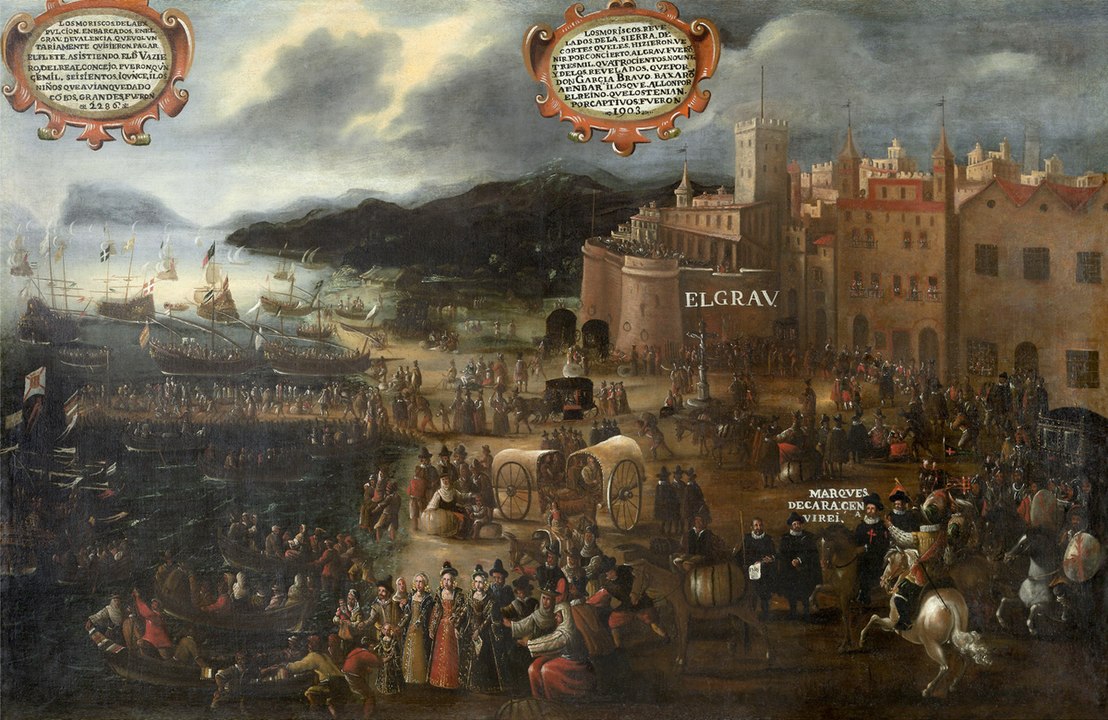
The WP page on the expulsions contains some contradictory information on the numbers involved. But they cite historian Trevor Dadson as estimating that, “out of a total Morisco population of 500,000, a figure accepted by many, around 40% avoided expulsion altogether and tens of thousands of those expelled managed to return.”

